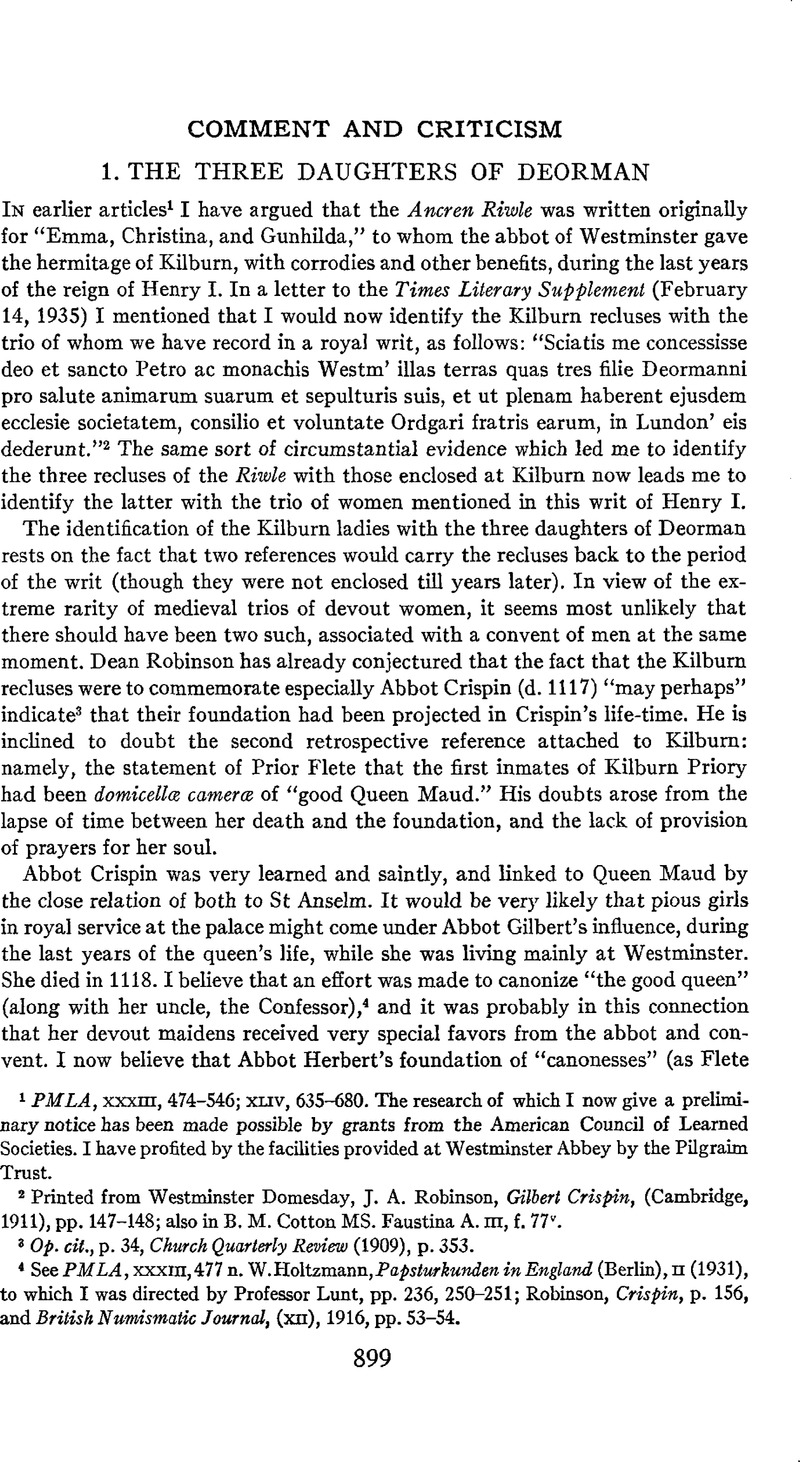No CrossRef data available.
Published online by Cambridge University Press: 02 December 2020

1 PMLA, xxxiii, 474–546; xliv, 635–680. The research of which I now give a preliminary notice has been made possible by grants from the American Council of Learned Societies. I have profited by the facilities provided at Westminster Abbey by the Pilgraim Trust.
2 Printed from Westminster Domesday, J. A. Robinson, Gilbert Crispin, (Cambridge, 1911), pp. 147–148; also in B. M. Cotton MS. Faustina A. iii, f. 77v.
3 Op. cit., p. 34, Church Quarterly Review (1909), p. 353.
4 See PMLA, xxxiii, 477 n. W. Holtzmann, Papsturkunden in England (Berlin), ii (1931), to which I was directed by Professor Lunt, pp. 236, 250–251; Robinson, Crispin, p. 156, and British Numismatic Journal, (xii), 1916, pp. 53–54.
4a The foundation is generally dated 1134, but Westminster was in 1133 involved in a bitter quarrel with Gilbert the Universal, bishop of London (Holtzman, ii, 241). It is unlikely that he would have later granted Westminster full power over this nunnery in his see (in any case a remarkable act, since the house was never Benedictine). See PMLA, xxxiii, 474, n., 489 ff.
5 In the late eleventh century Abbot Crispin's mother retired with two companions to the abbey of Bec (see PMLA, xxxiii, 539, n.); in the mid-twelfth, in England, a countess of Oxford (who was by birth a Clare) retired to the house of canons at St. Osyth's (J. H. Round, Geoffrey de Mandeville [London, 1892], p. 390). See also G. G. Coulton, Five Centuries of Religion, i (Cambridge, 1923), 241.
6 Letters of fraternity were often issued to great persons of no very real piety, but the present instance is likely to indicate a personal act. For women, rich enough to bestow sufficient land to buy Westminster fraternity, not to marry, probably in itself indicates piety. No such early case of lay private persons becoming associates of a monastery is cited in Prebendary Clark—Maxwell's valuable articles in Archaeologia, lxxv, 19–60; lxxix, 179–216. The Scottish royal family (the parents of Queen Maud), St. Margaret, her husband and children, were received into the fraternity of Durham (ibid., ixxv, 27). I wish to thank Prebendary Maxwell for kind assistance.
7 The Commune of London (London, 1899), p. 102.
8 Calendar of Charter Rolls, ii, 71–72. In spite of all that has been written on this family this inspeximus has escaped notice. Cf., for Algar, W. Dugdale, St Paul's (London, 1818), p. 256; Round, in Domesday Commemoration, Domesday Studies, ed. P. E. Dove (London, 1891), ii, 558; on Derman and Tierri, Trans. London and Middlesex Archaeol. Soc., iii, 153 ff.; Round, V. C. B., Herts, i, 285–286, Commune, p. 106, The King's Serjeants (London, 1911), p. 13; W. Page, London (London, 1923), pp. 211, 253, etc. Mr. Page rejects the identification (v. infra) of the two Domesday “Dermans” (taking, more positively than it was given, a suggestion of Mr. Round's).
9 This person's brother probably lived till 1115 (Page, op. cit. p. 249, LTLS, Feb. 14, 1935, and English Hist. Rev., 34, p. 369 n.). Cf. V. C. H., Herts, loc. cit.; H. W. C. Davis, Regesta Regum Anglo-N ormannorum (Oxford, 1913), No. 399, p. 101. I shall discuss later one or more contemporary more obscure persons named Derman.
10 For my opinion as to the age of the anchoresses of the Riwle see PMLA, xxxiii, 477–478 (n.), and (by implication) MLR, xxix. (April, 1934), 173, n. 1, where I suggest a date of “about 1140, or even possibly a few years later” (on the supposition that Kilburn was founded c. 1134). I now realise that puella in the foundation charter of Kilburn means merely virgo; see C. Johnson, Medieval Latin Word-List (Oxford, 1935). I find no address to the sisters in the Riwle that certainly implies their youth at the moment. On the other hand, the tone is adapted to persons much younger than St. Aelred's recluse sister (see PMLA, xxlv, 659). The range of possible age is probably that indiated by Latin juvenis; see my Writings Ascribed to Richard Rolle, MLA. Monog. iii (1927), p. 539.
11 See Charter Rolls, loc. cit., Bishops and Reform, M. Gibbs, and J. Lang. (Oxford, 1934), p. 192; Register of Giffard, Worcestershire Historical Society (1902), pp. xxiv ff.; Register of Giffard, Surtees Society, 109, xiv n. I shall show later other possible links, with the Clare connection, of the Ancren Riwle through the Merton copy and the “Dublin Rule.”